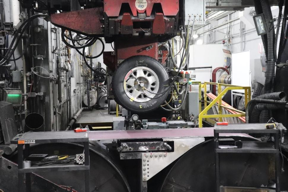Home > Press > Tests find no free-standing nanotubes released from tire tread wear
 |
Abstract:
A tire with a tread enhanced with single wall carbon nanotubes was exposed to accelerated wear and handling simulation tests by Akron Rubber Development Laboratory.
Analysis of captured airborne particles showed no free-standing nanotubes.
No aerosolized nanotubes in the air during simulation of the life cycle of tires unlocks the door to mass use of single wall carbon nanotubes that have tire industry-acknowledged benefits: improved safety and durability, and reduced energy consumption and vehicle CO2 emissions.
Tests find no free-standing nanotubes released from tire tread wear
Luxembourg | Posted on September 8th, 2023
Single wall carbon nanotubes, also known as graphene nanotubes, offer unique benefits in comparison to standard tire additives, such as silica and carbon black, leading to a growing number of projects for developing safer and more eco-friendly tires. Possible release of nanoparticles into the air was of interest for the tire industry, which is heavily focused on environmental aspects. OCSiAl, the worlds largest producer of single wall carbon nanotubes, took a lead in initiating wear simulation tests of a tire enhanced with nanotubes.
The test was performed by ARDL (Akron Rubber Development Laboratory), at a Calspan facility in Cleveland, OH. We have introduced TUBALL nanotubes produced by OCSiAl into tread to check the probability of nanoparticles exposure, as this tire component experiences the main wear during the cars motion. An independent laboratory captured any possible aerosol released and applied a specific quantification method relying on Raman spectroscopy for the detection of airborne particles. Only rubber particles with nanotubes embedded into the matrix were discovered. No free-standing TUBALL nanotubes were observed, said Gunther Van Kerckhove, H&S Lead Manager at OCSiAl.
The performed test once again verifies the results shown by VITO, a leading independent European research and technology organization, in 2017 during abrader tests on single wall carbon nanotube-enhanced epoxy, polyethylene, and elastomer samples. Taber abrading tests revealed no free-standing or protruding nanotubes in those tests. The reason lies in single wall carbon nanotubes bonding strength and their unique morphology: ultra-flexible with a 3000:1 length-to-diameter ratio.
Exposure monitoring studies with material samples are not sufficient for the tire industry. We wanted to check the exposure of a real tire with nanotubes during wear similar road conditions to check potential impact to human health and the environment. After confirming that no single wall carbon nanotubes are expelled during tire usage, the next step will be to verify that there is no exposure during recycling of a tire either, said Jean-Nicolas Helt, Development and Support Leader for Elastomers at OCSiAl.
Single wall carbon nanotubes are currently the only market solution allowing the industry to achieve a long-awaited breakthrough in tires: improved durability and safety on the road and reduced energy consumption, leading to cost savings and lower CO2 emissions to the environment.
####
For more information, please click here
Contacts:
Anastasia Zirka
Senior PR & Advertising Manager
OCSiAl Group
+352 20882321 ext:203
Copyright © OCSiAl Group
If you have a comment, please Contact us.
Issuers of news releases, not 7th Wave, Inc. or Nanotechnology Now, are solely responsible for the accuracy of the content.
News and information
![]()
New compound unleashes the immune system on metastases September 8th, 2023
![]()
Machine learning contributes to better quantum error correction September 8th, 2023
![]()
Quantum powers researchers to see the unseen September 8th, 2023
Possible Futures
![]()
New compound unleashes the immune system on metastases September 8th, 2023
![]()
Machine learning contributes to better quantum error correction September 8th, 2023
![]()
Quantum powers researchers to see the unseen September 8th, 2023
Nanotubes/Buckyballs/Fullerenes/Nanorods
![]()
Detection of bacteria and viruses with fluorescent nanotubes July 21st, 2023
![]()
Current and Future Developments in Nanomaterials and Carbon Nanotubes: Applications of Nanomaterials in Energy Storage and Electronics October 28th, 2022
![]()
Buckyballs on gold are less exotic than graphene July 22nd, 2022
Discoveries
![]()
Training quantum computers: physicists win prestigious IBM Award September 8th, 2023
![]()
Quantum powers researchers to see the unseen September 8th, 2023
Announcements
![]()
Training quantum computers: physicists win prestigious IBM Award September 8th, 2023
![]()
Machine learning contributes to better quantum error correction September 8th, 2023
![]()
Quantum powers researchers to see the unseen September 8th, 2023
Automotive/Transportation
Safety-Nanoparticles/Risk management
![]()
Billions of nanoplastics released when microwaving baby food containers: Exposure to plastic particles kills up to 75% of cultured kidney cells July 21st, 2023
![]()
Advances in nanotechnology application in biosafety materials A crucial response to COVID-19 pandemic June 9th, 2023
![]()
Underwater movement sensor alerts when a swimmer might be drowning October 7th, 2022
![]()
New protocol for assessing the safety of nanomaterials July 1st, 2022










